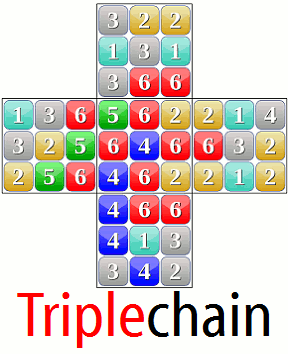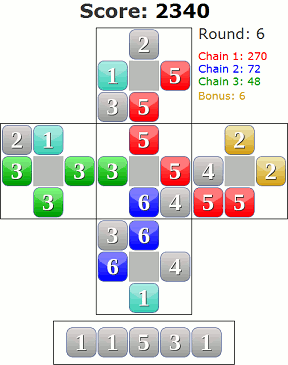
Each game consists of nine rounds of five dice. Your goal is to arrange the dice in the grid so that they create chains of numbers, joined horizontally, vertically, and diagonally. The larger your chain and the more quadrants you can touch with each chain, the more you can score. However, there are restrictions on where you can place dice on each turn. You can only place one die into each of the five quadrants (quintrants?) with each round, and the spaces in each quadrant open up in a certain order, starting with the sides (four rounds), corners (four rounds), and then the centers (one round).
In addition to placement rules, scoring each game has its own set of rules. Chains can only be made from 3s, 4s, 5s, and 6s. Each chain is scored by multiplying the number on the dice x how many times that number is in the chain x how many quadrants the chain is in squared. Thus, a key strategy is to spread the chains across the board and in all different directions to cover as much ground as possible. In addition, 1s and 2s can add to a bonus multiplier, but only if 2s are kept in chains of exactly two dice (+2x per pair) and 1s are in no chains at all (+1x each).
(Sigh.) Got all that? Your round of five dice appear at the bottom of the grid. Simply drag the dice to where you want them to go, and your score automatically updates with each move. Your three highest chains are marked with red, blue, and green, with 1s and 2s earning bonuses marked in aqua and yellow. If you can plan ahead and get some lucky rolls, the high score board awaits you!
 Analysis: I promise you, the rules are much simpler than the brick of text above makes it seem. If you're still having trouble getting a hang of how the game works, there's a speedy basic explanation and full walkthrough available on the site. Once you get the basics of the game down, you'll keep trying to top your own scores and possibly the daily leaderboards as well.
Analysis: I promise you, the rules are much simpler than the brick of text above makes it seem. If you're still having trouble getting a hang of how the game works, there's a speedy basic explanation and full walkthrough available on the site. Once you get the basics of the game down, you'll keep trying to top your own scores and possibly the daily leaderboards as well.
While the game is somewhat lacking on sounds and fancy graphics, the simple interface is perfect for a game that stresses more mental gymnastics than fast fingers. Registration allows you to save your high-scoring games and play a multiplayer mode, where you race against a clock to try to score higher than your opponents with the same dice (note that it's still in beta, so expect bugs). Even if you don't register, you can still submit a nickname for a high score.
Once you get a hang of the rules, Triplechain is a quick diversion that has an odd way of luring you into playing again and again. "Surely I could beat my score from last game, couldn't I?" you ask yourself, and then you miss the 2:30 appointment because you've been trying for so long. It only takes a few minutes to play, then a few more to play again, and again, and again...





7462 points with a bonus of 13.
Sounds more complicated than it is.
12348 points on the first try!
Once I got the hang of the bonus system, and got a little luck, I got 22944 (bonus 12).
I like these types of games a lot, but I found all the placement rules a bit too constraining. It's like the game is forcing you to plan ahead by not allowing you to link big chains early on, at the expense of strategic fluidity. In fact, I suspect it might make the game rely more on luck, since you have no control over which spaces to leave open and therefore can't maximize the number of possible connections. The last round in particular is highly dependent on which 5 dice you're dealt, so often you're left choosing between the lesser of evils rather than the greatest good.
But at the same time, giving the player free rein over where to place dice ultimately leads to luck-based games too, at least once you get the hang of good planning. There has to be some medium, though; maybe lifting either the positional constraints (probably the better one to get rid of) or the 1 dice per quadrant limit, but not both.
Thanks for the write-up Artbegotti! Really appreciate the kind words.
zxo: Good feedback - you're absolutely right. I have plans for an advanced version of the game that will have a much higher skill/luck ratio, but I wanted the basic version to give everyone a shot to put up good scores.
I think the constraints are necessary to prevent the game from being too easily solvable, but I'm open to being convinced otherwise. Their major drawback is that getting on the all-time high scores list requires a good deal of luck. I think a skilled player will beat a rookie almost every time when given the same board though.
I'm getting so frustrated of this game. It keeps closing the game window when I'm playing it:(
What about the possibility of being able to reserve a cube a couple of times per game? Like say you knew that you were going to want to put a 5 in the very center, you can put a 5 to the side which would be replaced with another random number for the immediate turn.
This would make it easier to get higher scores, but it would be another element of strategy to consider.
Update